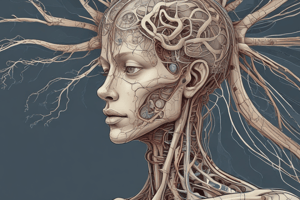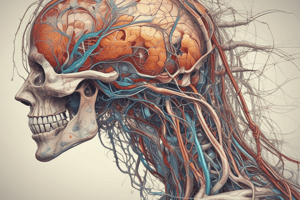Podcast
Questions and Answers
Match the following parts of a neuron with their functions:
Match the following parts of a neuron with their functions:
Dendrites = Receive signals from other neurons Cell Body = Contains the nucleus and organelles Axon = Transmits signals away from the cell body Myelin Sheath = Insulates the axon and speeds up signal transmission
What is the function of the cerebrum?
What is the function of the cerebrum?
Higher brain functions such as thought, emotion, and sensory processing.
The __________ lobe is responsible for vision.
The __________ lobe is responsible for vision.
occipital
The spinal cord is part of the peripheral nervous system.
The spinal cord is part of the peripheral nervous system.
Which of the following nerves is NOT part of the brachial plexus?
Which of the following nerves is NOT part of the brachial plexus?
What is the primary function of the hypothalamus?
What is the primary function of the hypothalamus?
Which part of the ear is responsible for balance?
Which part of the ear is responsible for balance?
The __________ is the muscle that controls the movement of the eye.
The __________ is the muscle that controls the movement of the eye.
What is the function of the pancreas in the digestive system?
What is the function of the pancreas in the digestive system?
Match the following cranial nerves with their primary functions:
Match the following cranial nerves with their primary functions:
Flashcards
Neuron Structure
Neuron Structure
A nerve cell with dendrites, cell body, nucleus, axon, and neuroglia.
Myelin Sheath
Myelin Sheath
Fatty insulation around some axons, increasing signal speed.
Cerebrum Lobes
Cerebrum Lobes
The largest part of the brain, divided into frontal, parietal, temporal, and occipital.
Brain Stem
Brain Stem
Signup and view all the flashcards
Cranial Nerves
Cranial Nerves
Signup and view all the flashcards
Meninges
Meninges
Signup and view all the flashcards
Spinal Cord White Matter
Spinal Cord White Matter
Signup and view all the flashcards
Spinal Cord Gray Matter
Spinal Cord Gray Matter
Signup and view all the flashcards
Peripheral Nerves
Peripheral Nerves
Signup and view all the flashcards
Eye Components
Eye Components
Signup and view all the flashcards
Study Notes
Human Anatomy Lab Exam III Review
-
Neuron Slide: Includes dendrites, cell body, nucleus, axon, and neuroglia cells.
-
Neuron Model: Contains dendrites, cell body, axon, myelin sheath, and Schwann cells.
-
Brain Model: Shows the cerebrum, including gyri, sulci, fissures, frontal lobe, parietal lobe, temporal lobe, occipital lobe, corpus callosum, diencephalon, thalamus, hypothalamus, brain stem (midbrain, pons, medulla oblongata), and cerebellum.
-
Ventricle Model: Highlights lateral ventricles (1st and 2nd), 3rd ventricle, cerebral aqueduct, and 4th ventricle.
-
Cranial Nerve Model: Covers olfactory, optic, trigeminal, and vagus nerves.
-
Spinal Cord Cross-Section Model: Shows white matter, gray matter, sensory neurons, posterior (dorsal) root, and anterior (ventral) root of spinal nerve, as well as posterior/dorsal rami, anterior/ventral rami, and sympathetic rami (sympathetic chain). Also includes dura matter, arachnoid, subarachnoid space, and pia matter.
-
Spinal Cord Model: Demonstrates white matter, gray matter, sensory and motor neurons, and spinal nerves, including rami. Includes meninges: dura matter, arachnoid, pia matter
-
Spinal Cord Board Model: Details conus medullaris, cauda equina, filum terminale, cervical plexus, brachial plexus, intercostal nerves, lumbar plexus, and sacral plexus.
-
Nerve Board Model: Focuses on cervical plexus.
-
Arm Model: Shows ulnar, radial, median nerves, and musculocutaneous nerve, brachial plexus, and axillary nerve.
-
Leg Model: Highlights femoral, sciatic, tibial, and common fibular nerves.
-
Small Arm Nerve Model: Details ulnar, median, and radial nerves.
-
Eye Model: Covers lateral rectus, medial rectus, superior rectus, inferior rectus, superior oblique, inferior oblique, sclera, cornea, choroid, ciliary body/process, iris, pupil, and retina, and anterior segment of eye.
-
Eye Board Model: Details lens, lacrimal gland, sclera, cornea, choroid, ciliary body, ciliary processes, iris, pupil, retina, anterior chamber, posterior chamber, and optic nerve.
-
Ear Model: Includes auricle, external auditory meatus (canal), tympanic membrane, oval window, malleus, incus, stapes, round window, pharyngotympanic tube, cochlea, vestibule, and semicircular canals, including cranial nerve VIII (vestibulocochlear nerve).
-
Endocrine Gland Model: Includes the hypothalamus, pituitary gland, thyroid gland, thymus, pancreas, adrenal glands, ovaries, and testicles.
-
Midsagittal Face/Neck Model: Emphasizes hypothalamus, pituitary gland, and nasal cavity.
-
Thorax Model: Covers larynx, trachea, bronchi, bronchioles, right lung, left lung, pulmonary arteries, and pulmonary veins.
-
Respiratory System Model: Demonstrates the nasal cavity, pharynx, larynx, trachea, bronchi, right lung, left lung, bronchioles, alveolar sacs, pulmonary alveoli, pulmonary artery, pulmonary vein, and capillary plexus.
-
Digestive Board Model: Shows tooth, tongue, palate, pharynx, esophagus, esophageal sphincter, stomach, pyloric sphincter, pancreas, spleen (gallbladder and liver).
-
Liver, Gallbladder, and Pancreas Model: Details the left and right lobes of the liver, hepatic ducts (common hepatic duct), gallbladder, cystic duct, common bile duct, and pancreas, pancreatic duct, and duodenum.
-
Liver Model: Shows the right and left lobes of the liver, hepatic ducts (common hepatic duct), gallbladder, cystic duct, common bile duct, hepatic artery, hepatic portal vein, and hepatic veins.
-
Pancreas Model: Highlights the celiac trunk, splenic artery, common hepatic artery, hepatic ducts (common hepatic duct), gallbladder, cystic duct, and common bile duct.
-
New Torso and Man Models: Illustrates larynx, trachea, lungs, thyroid gland, thymus, adrenal gland, salivary glands, esophagus, esophageal sphincter, stomach, pyloric sphincter, pancreas, spleen, lymph nodes, gallbladder, liver, small intestine (duodenum, jejunum, ileum), ileocecal valve, large intestine (cecum, appendix, ascending colon, transverse colon, descending colon, sigmoid colon, rectum).
Studying That Suits You
Use AI to generate personalized quizzes and flashcards to suit your learning preferences.




